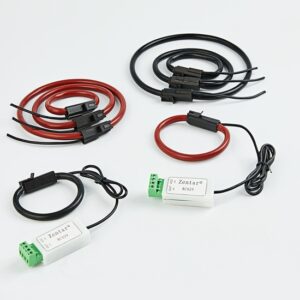Filtering power capacitors, common mode inductors, and magnetic beads are common shadows in the power supply circuit of EMC design schemes, and they are also the three major artifacts for solving interference signals.
Regarding the effects of these three in the power circuit, I firmly believe that many technical engineers do not understand. The content of the article analyzes the basic principles of solving the three EMC artifacts from the design plan.
1. Coupling capacitor
Although the resonance of the capacitor is undesirable from the perspective of filtering out high-frequency noise, the series resonance of the capacitor is not always harmful.
If the frequency of the noise that you want to filter out is clear, you can adjust the volume of the capacitor to make the series resonance point just fall on the disturbing frequency.
In specific engineering projects, the frequency of magnetic induction noise to be filtered usually reaches more than 100 MHz, or even exceeds 2GBHz. For such high-frequency magnetic induction noise, through-core capacitors must be used to filter out reasonably.
inductance
Generally, capacitors cannot filter out high-frequency noise reasonably because of two reasons:
(1) One reason is that the capacitor wire inductance causes the capacitor to resonate in series, which exhibits a large impedance to the high-frequency data signal, which weakens the bypass effect of the high-frequency data signal;
(2) Another reason is that the parasitic capacitance in the middle of the transmission line causes the high-frequency data signal to be coupled, which reduces the actual filtering effect.
Through-core capacitors can often filter out high-frequency noise reasonably, because the through-core capacitor not only has wire inductance, which leads to the problem of too low series resonance of the capacitor.
And the through-core capacitor can be immediately installed on the metal material control panel, and the metal material control panel has the effect of high frequency isolation. However, when applying through-core capacitors, the problem to be aware of is the installation problem.
The disadvantage of the larger feedthrough capacitor is that it is afraid of high temperature and temperature shock, which causes great difficulties when welding the feedthrough capacitor to the metal control panel.
Many capacitors are destroyed during the whole process of electric welding. Especially when a lot of through-core capacitors must be installed at the control panel, only one of them is destroyed, and it is difficult to recover, because when the damaged capacitor is removed, other adjacent capacitors will be destroyed.
2. Common mode inductance
Because most of the difficulties encountered in EMC are common-mode interference, common-mode inductors are also one of the most common powerful components.
Common mode inductance is a common mode interference suppression component that uses ferrite as the transformer skeleton. It consists of two electromagnetic coils with the same specifications and the same number of coil turns. The coil inductance is on the same ferrite toroidal transformer skeleton. , To produce a four-terminal component, it is necessary to exhibit large inductance for common-mode data signals and have a suppression effect, while for differential-mode data signals to exhibit a small leakage inductance, it basically fails.
The basic principle is that the magnetic flux in the magnetic core accumulates when passing through the common mode current, and then has a very large inductance, which has a suppressing effect on the common mode current. When the two electromagnetic coils pass through the differential mode current, the magnetic core The magnetic fluxes cancel each other, and there is basically no inductance, so the differential mode current can have no attenuation coefficient basis.
Therefore, the common-mode inductance can reasonably suppress the common-mode interference data signal in the balanced route, and has no harm to all the differential-mode data signals normally transmitted in the route.
The following requirements should be considered when making common mode inductors:
(1) The coil inductance must be insulated from each other for the transmission lines on the electromagnetic coil transformer skeleton to ensure that the electromagnetic coil turns without short-circuit faults under the effect of instantaneous speed overvoltage;
(2) When the electromagnetic coil passes through the instantaneous speed and large current, the transformer skeleton does not need to be in a saturated state;
(3) The transformer skeleton in the electromagnetic coil should be insulated with the electromagnetic coil to avoid penetration between each other under the effect of instantaneous speed overvoltage;
(4) The electromagnetic coil should be as single-sided as the coil inductance, which can reduce the parasitic capacitance of the electromagnetic coil and improve the electromagnetic coil’s ability to work against instantaneous speed overvoltage.
In general, pay attention to selecting the frequency range to be filtered. The larger the common-mode impedance, the better. Therefore, we must look at the component materials when selecting the common-mode inductor. The key is to select the frequency based on the impedance frequency curve.
In addition, pay attention to the hazards of differential mode impedance to the data signal when selecting. The key concern is the differential mode impedance, and the high-speed port number should be paid attention to.
3. Magnetic beads
In the EMC design process of commodity digital circuit design, we often apply magnetic beads. The raw material of ferrite is iron die-cast aluminum or iron-nickel alloy. This kind of raw material has a high magnetic permeability, and it can be the winding resistance of the electromagnetic coil of the inductance. In the middle, the capacitors caused by high frequency and high resistance are the least.
Ferrite raw materials are generally used in high-frequency conditions. Due to their critical inductance characteristics at low frequencies, the loss on the network is not large. Under high frequency conditions, they are critically inductance characteristic ratio and change with frequency. In specific applications, ferrite raw materials are used as high-frequency attenuators for radio frequency circuits.
In fact, ferrite is well equivalent to the series connection of a resistor and its inductance. At low frequencies, the resistor is short-circuited by the inductor. At high frequencies, the impedance of the inductor becomes higher and higher, so that the amount of current flows through the resistor.
Ferrite is a costly device on which high-frequency kinetic energy is converted into energy, which is determined by the characteristics of its resistor. Compared with general inductors, ferrite beads have stronger high-frequency filtering characteristics.
Ferrite exhibits resistivity at high frequencies, and its characteristics are the same as inductors with a very low quality factor, so it can maintain a high impedance in the range of very frequency ranges, thereby improving high-frequency filtering efficiency.
In the low frequency band, the impedance is composed of the inductive reactance of the inductance. At low frequency, R is not large, and the permeability of the transformer skeleton is high, so the inductance is very large. L plays a key function, and the interference signal is suppressed by the reflective surface; and at this time, the transformer The loss of the skeleton is small, and all the components are a lossless, high-Q inductor. This type of inductance is very easy to cause series resonance. Therefore, in the low frequency range, it is sometimes possible that the effect of the application of ferrite beads will increase. .
In the high frequency range, the impedance is composed of resistor components. As the frequency increases, the permeability of the transformer skeleton decreases, resulting in a decrease in the inductance of the inductor and a decrease in the inductive reactance component.
However, at this time, the loss of the transformer skeleton is increased by the resistor component, which causes the total impedance to increase. When the high-frequency data signal is based on the ferrite, the interference signal is digested and absorbed and converted into energy.
Ferrite suppression components are widely used in pcb circuit boards, power plugs and mobile phone charging lines. For example, adding ferrite suppression components to the power plug channel end of the printed circuit board can filter out high-frequency effects.
The ferrite core or bead special type is used to suppress the high frequency influence and peak influence on the power cord and power plug. It also has the ability to digest and absorb the influence of the electrostatic induction discharge pulse current. The application of built-in magnetic beads is the key to built-in inductors and also depends on the specific application place.
A built-in inductor must be used in the coupling circuit. When it is necessary to eliminate unused EMI noise, the application of built-in magnetic beads is the best choice.
Where to use built-in magnetic beads and built-in inductors
Built-in inductors: radio frequency (RF) and wireless communications, information technology equipment, radar detection detectors, automotive electronics, cellular phones, pagers, audio output devices, personal digital assistants (PDAs), wireless remote control system software and its Low-voltage power supply system control module, etc.
Built-in magnetic beads: digital clock generation power circuit, filtering between digital integrated circuits and digital circuit design, I/O input/output internal RF connectors (such as serial communication, parallel port, computer keyboard, computer mouse, long-distance telecommunications network, Local area network), radio frequency circuits and easily affected logic devices, power supply circuits to filter out high-frequency transmission effects, electronic computers, copiers, video cameras (VCRS), TV systems and mobile phones EMI noise suppression.
The enterprise of magnetic beads is Oumu, because the enterprise of magnetic beads is tolerated according to the impedance caused by it at a certain frequency, and the enterprise of impedance is also Oumu.
The DATASHEET of the magnetic bead will generally show the characteristic trend graph of frequency and impedance, which is generally standardized at 100MHz. For example, at a frequency of 100MHz, the impedance of the magnetic bead is equivalent to 1000 ohms.
For the frequency range that you want to filter, you must choose the larger the magnetic bead impedance, the better. Under normal circumstances, choose the impedance above 600 ohms.
In addition, you must pay attention to the total flow of the magnetic beads when selecting the magnetic beads. Generally, it must be adjusted by 80% to solve the problem. When using the circuit, it is necessary to consider the damage of AC impedance to the loss.




